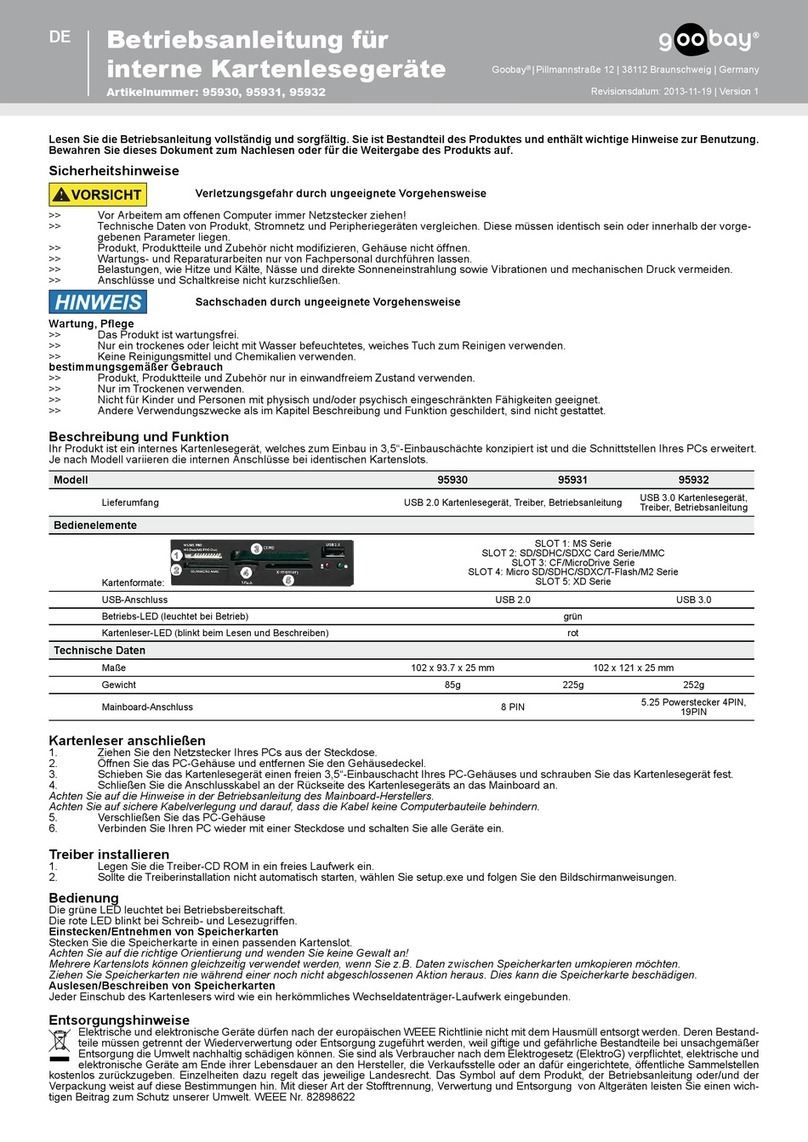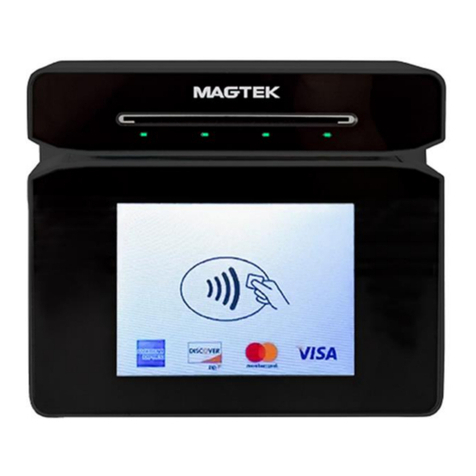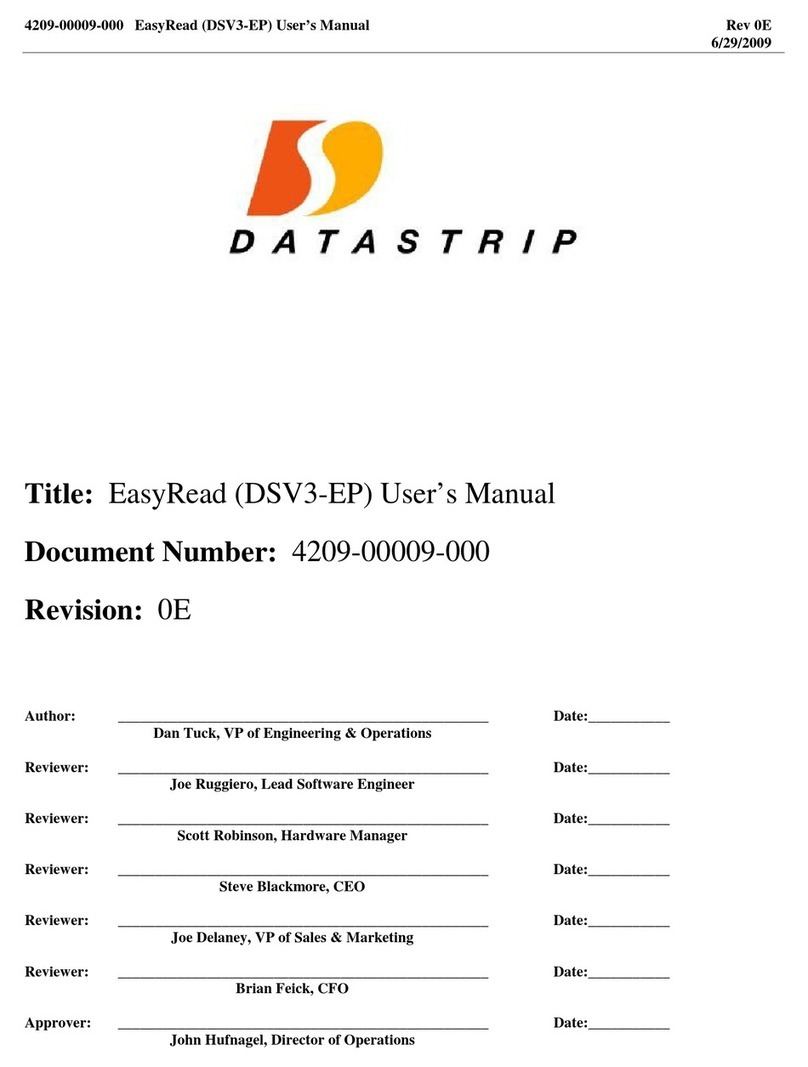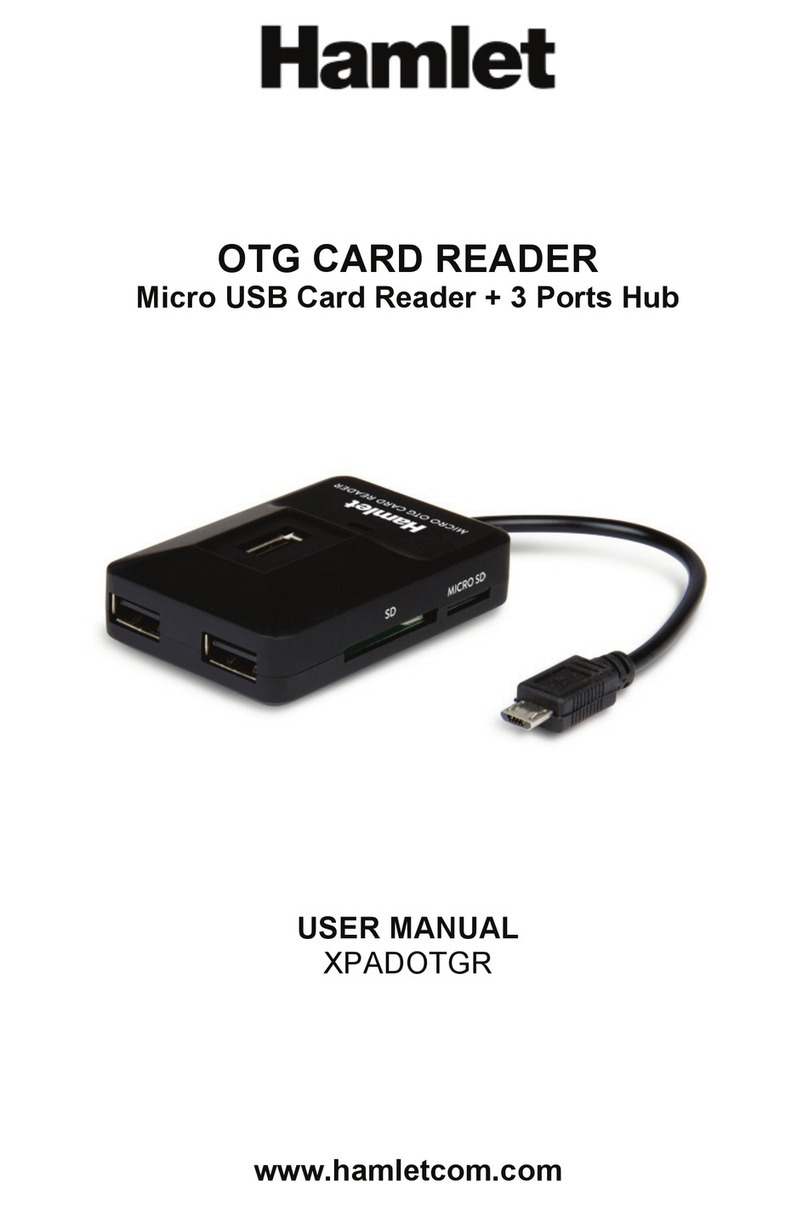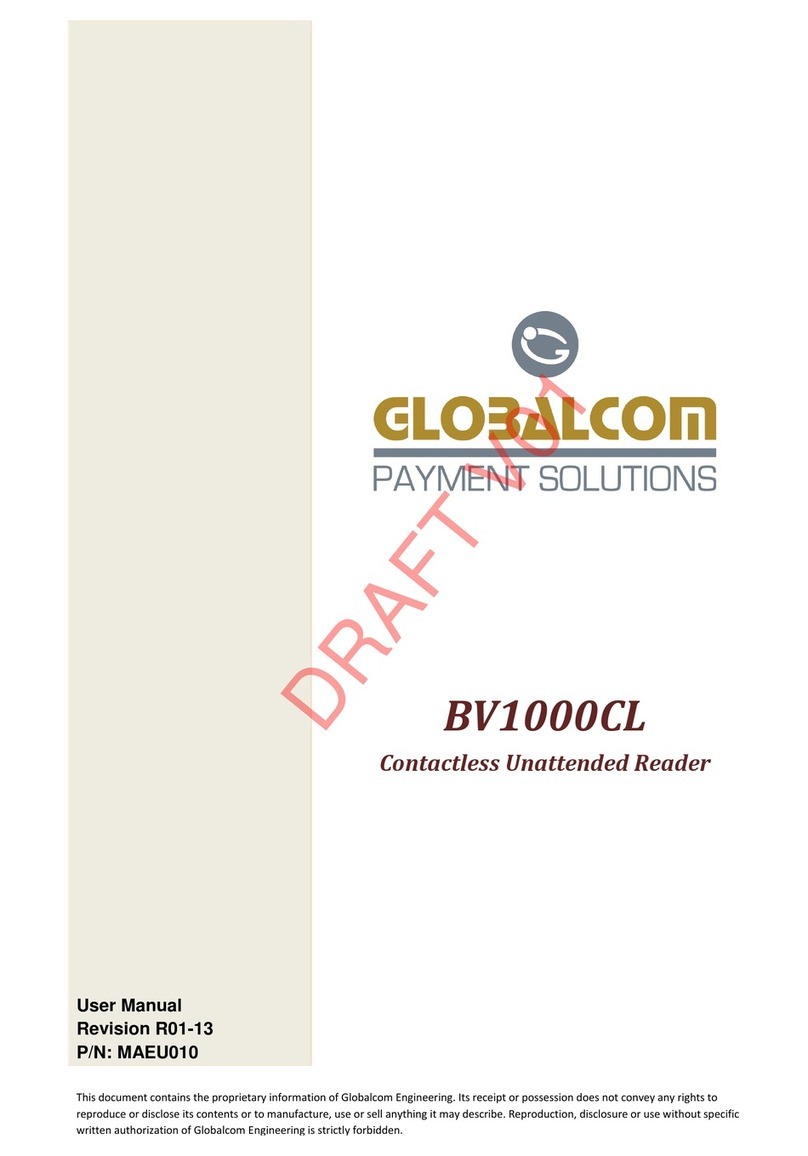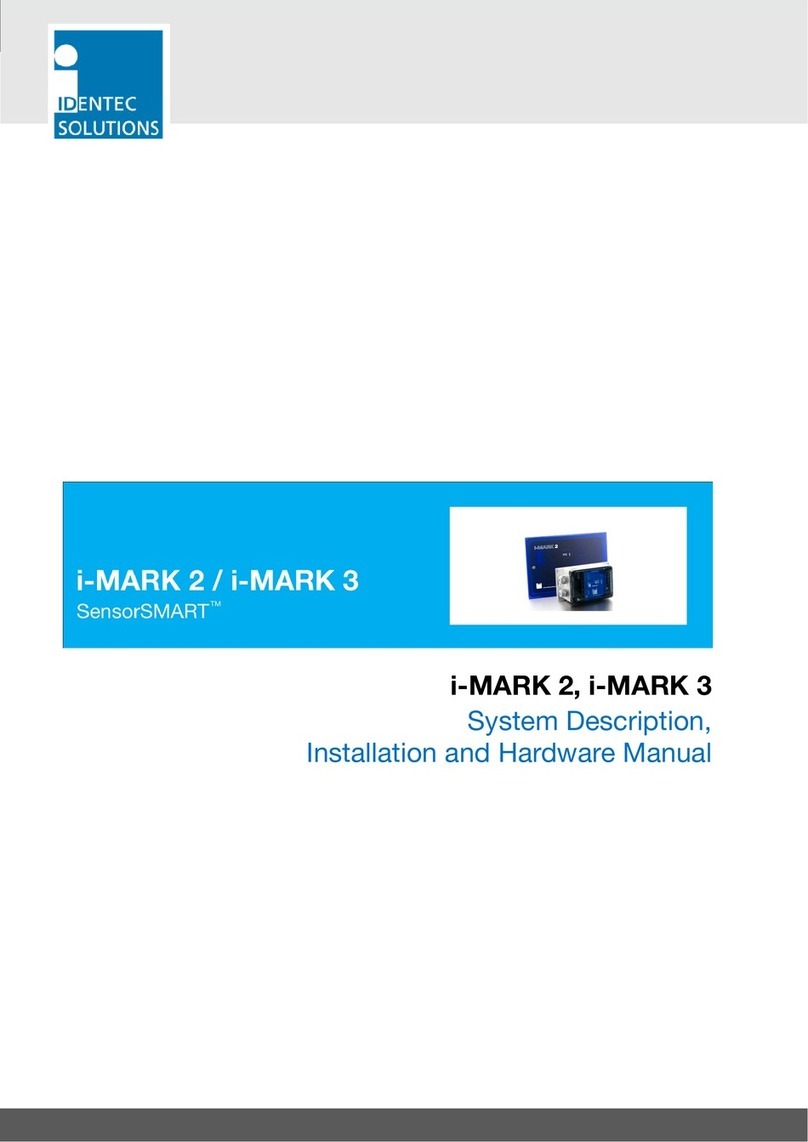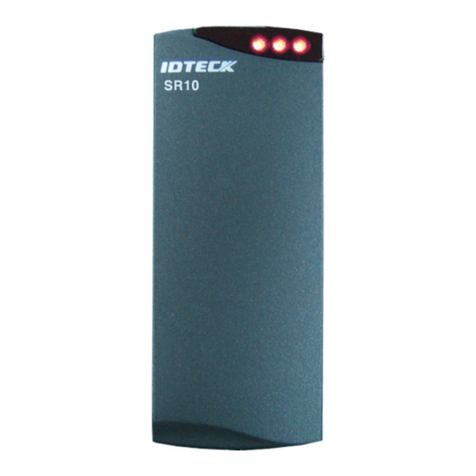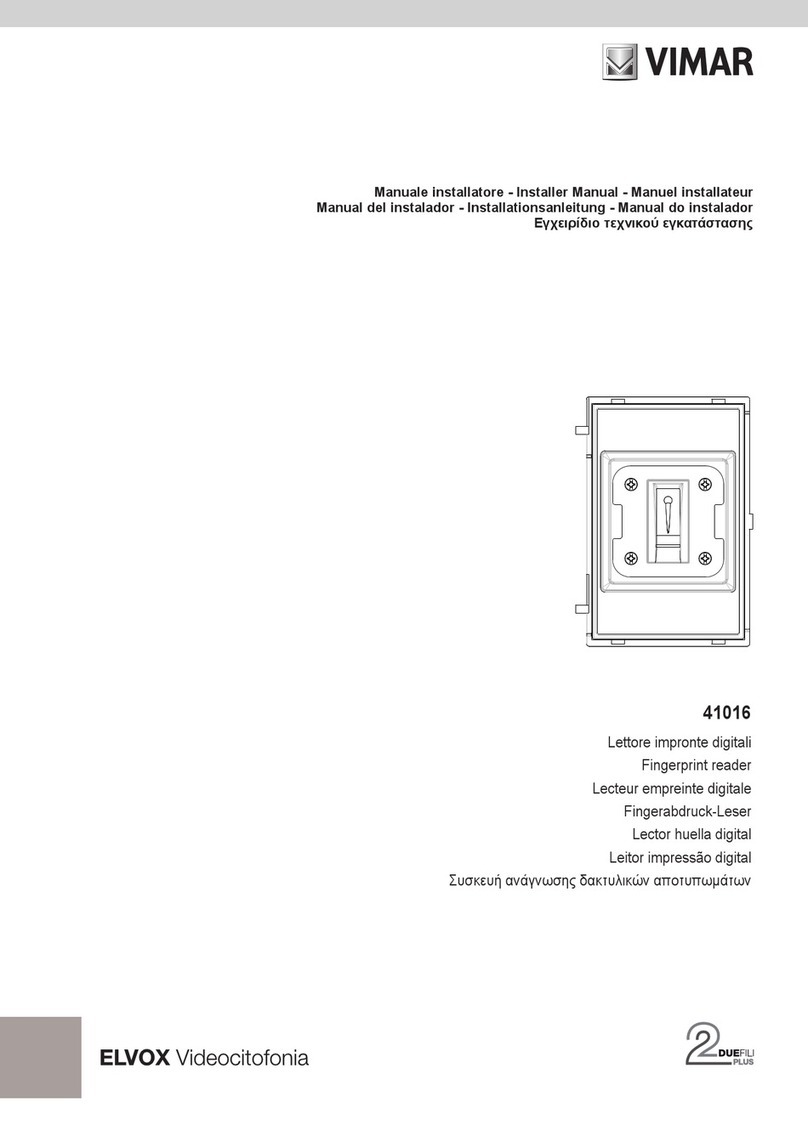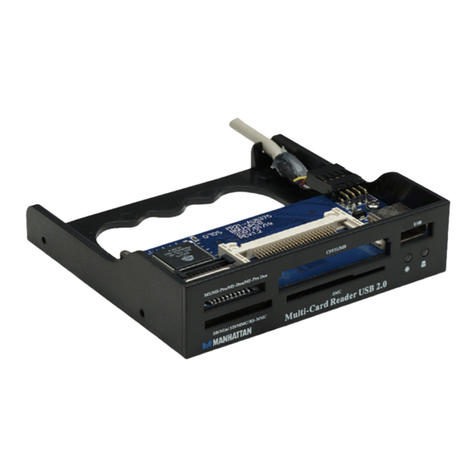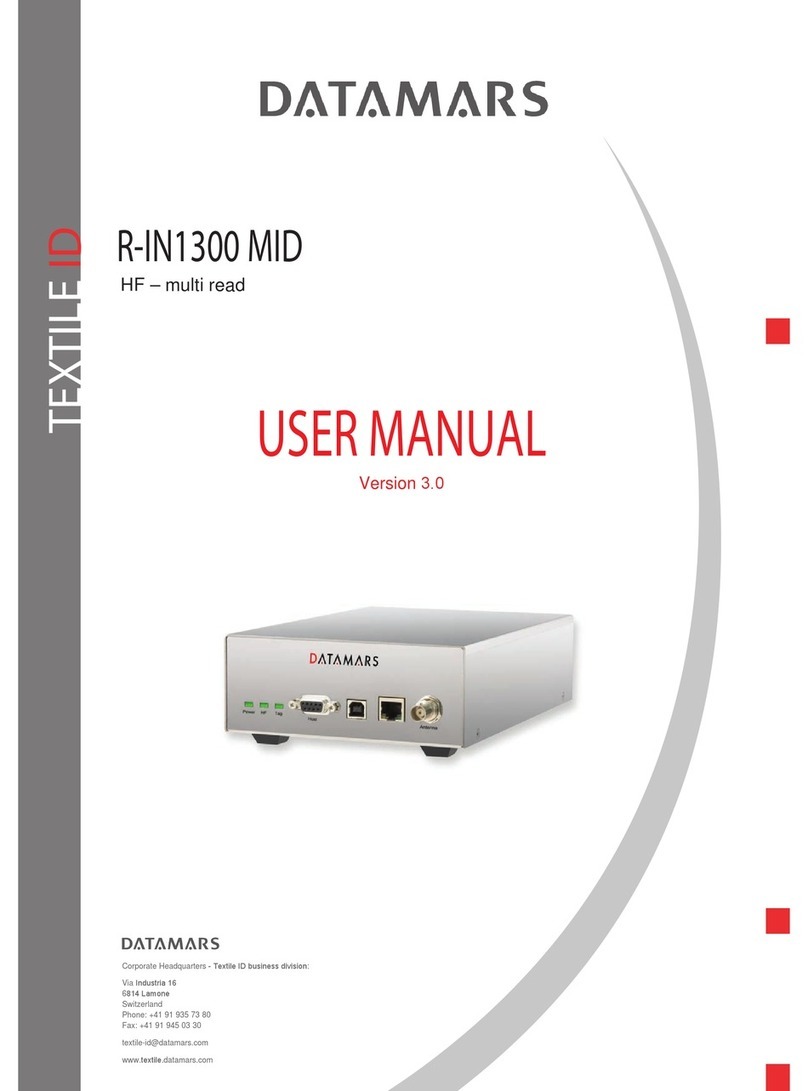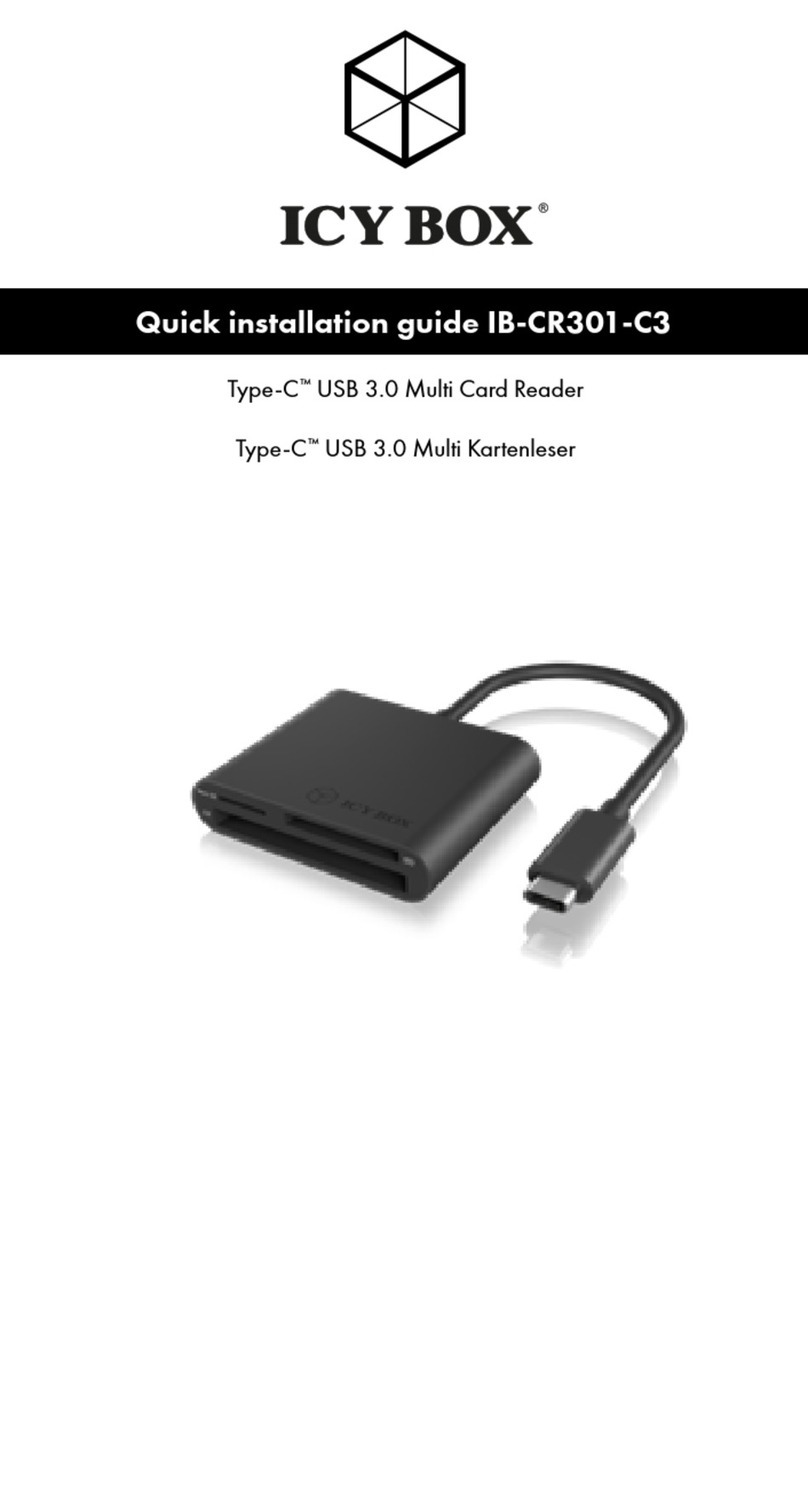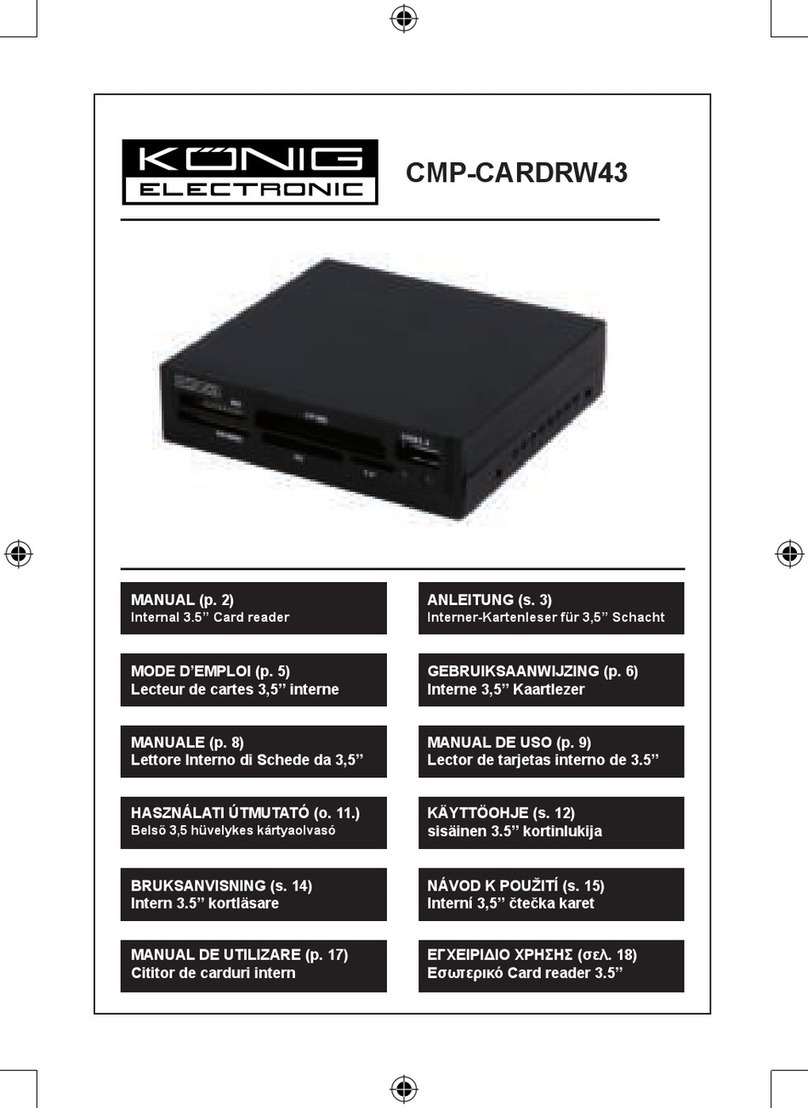Eelectron TR22A01KNX User manual

Pagina 1 di 24
Transponder Reader
TR22A01KNX
TR22A11KNX
Product Handbook
Product: Transponder Reader
Order Code: TR22A01KNX - TR22A11KNX
Application Program ETS: EEL_RDT1_10 Transponder Card Reader

Pagina
2 di 24
Index
Pag.
1
General Introduction............................................................................................................ 3
2.
Technical data ......................................................................................................................... 4
2.1
Wiring Diagram ....................................................................................................................... 5
2.2
Operating and display elements.................................................................................... 5
2.3
Dimension drawing............................................................................................................... 5
2.4
Mounting and wiring hints................................................................................................ 6
3.
Product and functional overview .................................................................................. 7
4.
Parameters ................................................................................................................................ 9
4.1
Parameter window “General Configurations”........................................................ 9
4.2
Parameter Window “Relay 1 Configuration” ........................................................ 11
4.3
Parameter Window “Relay 2 Configuration” ........................................................ 14
4.4
Parameter Window “Input 1 Configuration” ......................................................... 15
5
Communication Objects .................................................................................................. 18
6
Application Notes................................................................................................................ 22

Pagina
3 di 24
1 General Introduction
Eelectron is an Italian company with a focus on designing and manufacturing electronic devices
dedicated to building and home evolution and closely related software tools.
As of year 2005, Eelectron applies to KNX association, fulfilling his requirements with the main
goal of giving a contribution to the diffusion of the world’s only open Standard for home and
building automation.
Eelectron philosophy of comprehensive aesthetic design and engagement in developing
highly innovative devices, matched with KNX Interoperability and compliance with international
requirements, has engendered Eelectron’s distinct reputation.
Eelectron experience is devoted to end users, with a constant training activity, assistance on
products and a continuous development that deserves particular attention to upcoming needs
and applications, to energy saving and to solutions directed to make Users life easier and simpler.

Pagina
4 di 24
2. Technical data
Power Supply External Auxiliary Voltage
•
12 (24) V AC/DC ± 10%
Inputs Number
Input Signal Voltage
Input Signal Current (close contact)
•
2 (potential free)
•
Un = 24V
•
In = 1ma
Outputs relays Number
Output switching currents
•
2
•
24 VAC, 2A cosρ0.6.
Control Elements 1 programming push button
Display elements 1 LED red (back) for ETS programming
1 LED red/green (front)
1 LED red (front)
1 LED amber (front)
1 LED green (front)
•
“Access Not Allowed/Allowed“
signalling
•
“Room Occupied” or “Do not
Disturb” o other alarm
•
“Room Service Call” o other alarm
•
“SOS alarm” o other alarm
Physical
specifications and
Dimensions
Housing
Colours
Dimensions
Weight
Installation
•
plastic
•
Light Grey Varnished
(TR22A01KNX),
Dark Grey (TR22A11KNX)
•
(WxHxD): 110 x 78 x 37,1 mm
•
ca. 120 g.
•
flash mounting in 2-3 modules or
wall round box Ø60mm, 40mm
deep
Electrical Safety Pollution degree
Protection class
Safety class
Overvoltage category
•
2 (according to EN 60664-1)
•
IP20 (according to EN 60529)
•
III (according to EN 61140)
•
III (according to EN 60664-1)
CE Mark and
Certifications
CE
EIB/KNX
•
In accodance with EMC and Low
Voltage guidelines
•
According to EN 50090-1-2
Transponder Reader
The Transponder Reader TR22A01KNX is an EIB/KNX wall
mounting device suitable to access control application.
This device can be used in any kind of building (Hotel,
Hospital, Offices, Parking, etc..) where the access control
application is required.
The device is equipped with two binary inputs (potential free
contacts) that can be used, for instance, to control whether the
door lock has been opened or closed or other signals coming
from external switches/contacts (i.e. windows, bathroom
emergency alarms, etc..).
The transponder reader is equipped also with two output relays
which can be used for any purposes, typically to open the door
or turning on the courtesy light inside the room.
The device configuration for commissioning in terms of
physical address, group addresses and parameters is done
with ETS ( Engineering Tool Software) through a download of
the Application Program.
Order Code :
TR22A01KNX (Light Grey Varnished)
TR22A11KNX (Dark Grey)

Pagina 5 di 24
2.1 Wiring Diagram
2.2 Operating and display elements
2.3 Dimension drawing
Connections:
1 Power Supply 12/24 Vcc/ac
2 Power Supply 12/24 Vcc/ac
3 OUT 1 terminal relay 1 (NO)
4 OUT2 terminal relay2 (NO)
5 COM Outputs
6 IN 1 (potential free)
7 IN 2 (potential free)
8 COM Inputs
11 Bus Connection Terminal:
Black = bus polarity (-)
Red = bus polarity (+)
Operating Elements:
9 Programming LED
10 Programming push button
12 Led 4
13 Led 3
14 Led 2
15 Led 1
1
2
3
4
5
6
7
8
KNX
9
10
(11)
Input 2
Out 2
Input 1
Interfaccia BUS
KNX / EIB
Com
5
6
7
8
Com
Bassa tensione
max. 60 V ac/dc 2A
Alimentazione
12/24 V ac/dc
Out 1
1
2
4
3

Pagina
6 di 24
2.4 Mounting and wiring hints
The device may be used for permanent indoor installations in dry locations within wall
boxes.
Requirements for installation
•
The device must not be connected to 230V cables.
•
The prevailing safety rules must be heeded.
•
The device must be mounted and commissioned by an authorised installer.
•
The applicable safety and accident prevention regulations must be observed.
•
The device must not be opened. Any faulty devices should be returned to manufacturer.
•
For planning and construction of electric installations, the relevant guidelines, regulations
and standards of the respective country are to be considered.
Requirements for commissioning
•
Connect each single KNX/EIB bus core inside the bus connection terminal block
observing bus polarity .
•
Slip the bus connection block into the guide slot placed on the front side of this device
and press the block down to the stop.
•
In order to commission the device, a PC with ETS2 version V1.3 or higher is required as
well as an interface to the bus, e.g. via an RS232 interface or via a USB interface.
•
The device configuration (KNX physical address assignment) is done by pressing the
programming push button located on the front of the housing.
Supplied state
•
The device is supplied with the physical address 15.15.255.
•
It is therefore necessary to load parameters and group addresses during
commissioning. However the complete application program can be reloaded if required.
•
The bus connection terminal block is included in the package.
•
The instruction sheet is included in the package.
Manutenance
•
The device is maintenance free.
•
In case of damage during transportation or storage, no repairs my be carried out by
external staff.
•
When the device is opened the right to claim under guarantee expires.

Pagina
7 di 24
3. Product and functional overview
The Transponder Reader - TR22A01KNX/TR22A11KNX is an EIB/KNX wall mounting
device suitable to access control application.
This device can be used in any kind of building (Hotel, Hospital, Offices, Parking, etc..)
where the access control application is required.
The device is equipped with two binary inputs (potential free contacts) that can be used,
for instance, to control whether the door lock has been opened or closed or other
signals coming from external switches/contacts (i.e. windows, bathroom emergency
alarms, etc..).
The transponder reader is equipped also with two output relays which can be used for
any purposes, for instance in case of Hotel application to open the door or turning on
the courtesy light inside the room.
The product provides on the front side four LEDs in order to enlighten 4 icons to display
the following states (e.g. in case of Hotel management):
Access Allowed/Not Allowed
SOS request
Service Call (clean room, etc..)
Client status (“Busy room” or “Do not Disturb”)
The LEDs and icons can be configured in association with other alarms or events (see
LEDs signalling in the “Application Notes” included).
The transponder reader can reads cards or keys at a maximum distance of 30mm from
the front side.
The access control follows a sequence where the “Build Number” has been checked at
first, then the expiration data, next the password ID for client/guest/service identification,
then the enabled days of week and hours range. In case card reading pass all checks
the door is opened, the courtesy light inside is switched on and a specific 1 bit object
associated to the identified class of user is sent. At the same time the Transponder
Reader sends the access response to the bus in order to be detected and stored by a
visualization or management software..
The reader can identifies up to four types or classes of users through the reading of four
different ranges of passwords written in the cards created with the “Transponder
Encorder” (code: TE00A01USB).
This device provides also an alarm function by sending an “Alarm” object (1bit) to alarm,
for instance, a centralized visualization software (e.g. “eAccess” or “eHotel”) that a
power failure was occurred and then recovered next. This advice can be useful to
visualization and monitoring software to update some configuration data to the readers
and to the card holders or for other purposes.
The physical address, group address and parameters are assigned and programmed
with the ETS tool software. In order to commission the device, a PC with ETS2 version
V1.3 or higher is required as well as an interface to the bus, e.g. via an RS232 interface
or via a USB interface.
This device must be configured and loaded with the following application program:
EEL_RDT1_10 Transponder Card Reader

Pagina
8 di 24
With this application program the followng functions can be parametrized and configured:
Application Program: EEL_RDT1_10 Transponder Card Reader
Max number of group addresses: 35
Max number of group address associations: 32
General
Configurations
•
Single or Multiple (max 4) user groups identification
•
Grant date and grant days control enable
•
Power failure and recovery alarm enable
Input 1 (and 2)
Configuration
•
Switching states ON or OFF can be set depending on
input pulse adge evalutation (rising or falling edge).
•
Cyclical sending option at adjustable intervals
Relay 1 Configuration
•
“General Purpose” or “Door Open” function selection
•
Normally open or closed contact setting
•
Time switching (e.g.: “Door lock timing release”)
Relay 2 Configuration
•
“General Purpose” or “Courtesy Light” function selection
•
Normally open or closed contact setting
•
Time switching (e.g.: “Courtesy light timeout”)
Note: The default settings for the options are underlined (e.g. Options: no/yes)

Pagina
9 di 24
4. Parameters
4.1 Parameter window “General Configurations”
Fig. 1: Parameter Window “General Configurations”
•Access Send Mode
Options: Single Access
Different Access
Option “Single Access”: enables the 1 bit object (“Valid Access”) that is sent to the
bus in case a valid access has been identified by the reader. With this option only
one single group of users are managed in the range of passwords admitted.
Option “Different Access”: enables four 1 bit objects (“Access 1”, …, “Access 4”)
corresponding to the reading and entrance allowed of users whose password
belongs to one of four pre-defined range of passwords.
As a password is identified as belonging to one of these four classes, than the
object “Access X” is sent to the bus.
This feature allows the identification of users within these 4 classes (e.g. clients,
staff, maintenance service, emergency, etc..).

Pagina
10 di 24
•Grant Date Control
Options: ON
OFF
Option “ON”: enables expiration date control during transponder card or key reading.
Option “OFF”: disables expiration date control
•Grant Days Control
Options: OFF
ON
Option “OFF”: the days of week allowed for entrance are not checked.
Option “ON”: enables the days of week control.
Note: in both cases the transponder reader always reads and checks the timing hour
valid range associated to the card.
•Send Alarm
Options: OFF
ON
Option “OFF”: the device does not send the object “Alarm”
Option “ON”: the device sends the object “Alarm” in case of power failure after the
power supply has been recovered.
Note: this feature is useful to visualization software in order to re-send data to the
readers after a power failure in order to re-synchronize data and time with the
central unit (pc) or for any other purposes.

Pagina
11 di 24
4.2 Parameter Window “Relay 1 Configuration”
The Relay 1 configuration parameters are shown in the next window:
Fig. 2: Parameter Window “Relay1 Configuration”
Function
Options: General Purpose
Door Open
Option “General Purpose”: Relay 1 is controlled only by the “Relay 1” (1 bit)
communication object as normal independent binary output channel.
Option “Door Open”: the Relay 1 is switched (ON or OFF depending on option
selected in the next parameter “Contact”) if a valid transponder card is read or
via the “Door Unlock” (1 bit) communication object.
Contact
Options: Normally Open
Normally Close
Option “Normally Opened”:
Off telegram = contact open
On telegram = contact closed.
. Option “Normally Closed”:
Off telegram = contact closed
On telegram = contact open.

Pagina
12 di 24
Mode
Option: Normal
Timing
Option “Normal” : the Relay1 will be switched ON by sending an ON command
and will be switched OFF by sending an OFF command within the associated
object “Relay 1”.
The status of the relay contact can be inverted by parameter setting “Contact”:
Normally Close”.
Option “Timing”: enable the time switch function (e.g. electrical lock control). See
next.
Fig. 3: Parameter Window “Relay 1 Configuration” with Mode = “Timing”.
When an On telegram is received via the output object, it is routed directly to the
relay. The Off delay that has been assigned starts at the same time. Every
further “1” (ON) that is received before the timer has elapsed, resets the delay
and restarts it. Once the period has elapsed, a “0” is passed to the output. An
Off telegram deletes the Off delay and is immediately routed to the output.
The time for the Off delay is set here. This is calculated from the selected base
“TimeBase” multiplied by the factor “Factor” that is entered here:
T
ON
= TimeBase x Factor
Note: An attempt should always be made to set the required time with the
smallest possible base as the base that is selected here also simultaneously
specifies the maximum timing error.

Pagina
13 di 24
TimeBase
Options: 250ms, 500ms, 1Sec, 1Min, 1Hour
Factor
Options: 0…10…255
Fig. 4: Timing Mode (e.g. for electrical lock pulse operating control).

Pagina
14 di 24
4.3 Parameter Window “Relay 2 Configuration”
Relay 2 differs from Relay 1 only for the first parameter setting “Function”.
The Relay 2 configuration parameters are shown in the next window:
Fig. 5: Parameter Window “Relay 2 Configuration”
Function
Opzioni: General Purpose
Courtesy Light
Option “General Purpose”: Relay 2 is controlled only by the “Relay 2” (1 bit)
communication object as normal independent binary output channel.
Option “Courtesy Light”: the Relay 2 is switched (ON or OFF depending on
option selected in the next parameter “Contact”) if a valid transponder card is
read or via the “Courtesy Light” (1 bit) communication object.
All the other parameters are completely similar to “Relay 1 Configuration” settings, so
please see functional descriptions in par. 4.2.
Note: please see Outputs timing diagrams in “Application Notes”.

Pagina
15 di 24
4.4 Parameter Window “Input 1 Configuration”
Parameters associated to Input1 channel are the same as ones associated to Input 2.
Fig. 6: Parameter Window “Input 1 Configuration”
Mode
Options:
Rising ON
Rising OFF
Falling ON
Falling OFF
Rising ON / Falling OFF
Rising OFF / Falling ON
Toggle ON/OFF
Toggle OFF/ON
With this parameter we can program which status we need to send to the bus
(ON/OFF; TOGGLE) when a rising or falling edge is detected in the input signal.

Pagina
16 di 24
Behaviour:
“Rising On”: A rising edge causes a logic “1” to be transferred to the
communication object. A falling edge does not alter the object value.
“Rising Off”: A rising edge causes a logic “0” to be transferred to the
communication object. A falling edge does not alter the object value.
“Falling On”: A falling edge causes a logic “1” to be transferred to the
communication object. A rising edge does not alter the object value.
“Falling Off”: A falling edge causes a logic “0” to be sent to the communication
object. A rising edge does not alter the object value.
“Rising On, Falling Off”: A rising edge causes a logic “1” to be transferred to the
communication object. A falling edge causes a logic “0” to be sent.
“Rising Off, Falling On”: A rising edge causes a logic “0” to be transferred to the
communication object. A falling edge causes a logic “1” to be sent.
“Toggle ON/OFF”: Each rising edge causes the object value to be inverted. This
means that a logic “1” is sent to the communication object after the first rising
edge. The next one sends a logic “0” and so on. A falling edge does not alter the
object value.
“Toggle OFF/ON”: Each falling edge causes the object value to be inverted.
This means that a logic “1” is transferred to the communication object after the
first falling edge. The next one sends a logic “0” and so on. A rising edge does
not alter the object value.
Cyclic Send
Options: ON
OFF
This parameter enables the cyclical sending of current value of Input1 to the bus
at a set interval.

Pagina
17 di 24
Fig. 7: Parameter Window “Input 1 Configuration” with Cyclic Send enabled (ON).
Cycling Send Time (Min)
Options: 1…10…255
The cyclic time for sending telegrams repeatedly on the bus with Input1 current
value is specified here.
The time units are minutes.
Note: please see Inputs timing diagrams in “Appication Notes”.

Pagina
18 di 24
5 Communication Objects
The EIB/KNX communication objects provided within the application program
“EEL_RDT1_10 Transponder Card Reader” are shown next:
Fig. 8: Communication Objects (some objects are visible if enabled by specific parameter
setting).
Nr. Function Name Type Flag
0 On/Off Relay 1 / Door Unlock EIS1, 1bit
DPT 1.001
C,R,W,T
This object is received from the bus to control the output relay 1.
In case the “Door Open” function is enabled this object is named “Door Unlock” and the
relay 1 is switched also in case of valid transponder card reading and consequent
entrance acknowledge (for this usage the relay1 should be connected to a door lock).
In case the output relay is set as “Normally Open” contact the relay is closed when
value “1” is received and it is opened in case of value “0” (vice versa in case of
“Normally Closed” contact).
If Timing Mode is enabled when an On telegram is received via the Output object
(“Relay “1 or “Door Unlock”), it is routed directly to the relay 1. The Off delay that has
been assigned starts at the same time. Every further “1” (ON) that is received before the
timer has elapsed, resets the delay and restarts it. Once the period has elapsed, a “0” is
passed to the output. An Off telegram deletes the Off delay and is immediately routed to
the output.

Pagina
19 di 24
Nr. Funzione Nome Tipo Flag
1 On/Off Relay2 / Courtesy Light EIS1, 1bit
DPT 1.001
C,R,W,T
This object is received from the bus to control the output relay 2.
In case the “Courtesy Light” function is enabled this object is named “Courtesy Light” and
controls the relay 2 to be switched ON/OFF. Relay 2 is also switched ON/OFF in case of
valid transponder card reading and consequent entrance acknowledge (for this usage the
relay2 should be connected to the courtesy light).
In case the output relay is set as “Normally Open” contact the relay is closed when value
“1” is received and it is opened in case of value “0” (vice versa in case of “Normally
Closed” contact).
If Timing Mode is enabled when an On telegram is received via the Output object (“Relay
“1 or “Courtesy Light”), it is routed directly to the relay 2. The Off delay that has been
assigned starts at the same time. Every further “1” (ON) that is received before the timer
has elapsed, resets the delay and restarts it. Once the period has elapsed, a “0” is passed
to the output. An Off telegram deletes the Off delay and is immediately routed to the
output.
2,4,6 On/Off LedX EIS1, 1bit
DPT 1.001
C,R,W,T
The object LedX is used to control via bus the Ledx placed on the front of the housing.
In case a switching “ON” is received with this object the LedX is switched ON continuously
until a switching “OFF” signal is received.
This command has priority on the object “LedX Blink”.
For a LEDs signalling example please see “Application Notes” at par. 6.
3,5,7 Blink/Off LedX Blink EIS1, 1bit
DPT 1.001
C,R,W,T
It receives from the bus an activation or deactivation blinking command for the LedX.
The LedX blinks with a timing period of 0,5 sec.
For a LEDs signalling example please see “Application Notes” at par. 6.
8 Set Date Date EIS4, 3byte
DPT 11.001
C,R,W,T
The Date object value is used to syncronize the transponder reader with a visualization
software and to verify the access qualification of a valid card.
In the device and on the card the date is in dd,mm,yy format where “yy” is a number from
90 to 89 and corresponds to the years from 1990 to 2089.
The updating is normally done via bus at least one time a day and each time that the
supervision centre receives an “Alarm” signal (i.e. after a power failure).
9 Set Time Time EIS3, 3byte
DPT 10.001
C,R,W,T
The Time object value is used to verify the access qualification of a valid card and to
control the timing hour valid range.
The updating is done normally via bus at least one time a day and each time that the
supervision software (e.g. “eHotel” or “eAccess”) receives an “Alarm” signal (i.e. after a
power failure).

Pagina
20 di 24
Nr. Funzione Nome Tipo Flag
10 Set Plant ID Build Number EIS10, 2byte
DPT 7.001
C,W,T
The object “Build Number” is used to identify the installation or the building where the
transponder readers are installed.
This code avoid any possible risk of using the same card for entrance in two different
buildings. It is sent by the building management software during commissioning.
11 Password Guest Data NON EIS
10 byte
C,W,T
The object “Guest Data” is sent by the access control management software to the
transponder readers and holders in order to enable entrance and card identification once
the transponder card is read.
This object (non KNX standard object) contains the user password id, the expiration date,
the enabled timing entrance ranges, the valid entrance days of week and the expiration
data. After the “Build Number” reading and acceptance the transponder reader or holder
controls the password and any other information associated in order to allow or not allow
the room entrance.
“Guest Data” object is normally sent during transponder readers and holders configuration
by the access control software (“eAccess” or “eHotel”).
12 Access Data Access Code EIS12, 4byte
DPT 15.000
C,T
This object is used to send to the bus the result of a transponder card reading.
Within this object the password and some reading feedbacks are sent to the centralized
access control software (e.g.”eHotel” or “eAccess”) to be managed or stored.
13..16 Enable Access Access X EIS1, 1bit
DPT 1.003
C,R,T
If “Access Send Mode” has been set to “Different Access” than the four (1 bit) switching
objects “Access1”...”Access 4” are visualized.
This object is sent only after a card reading acknowledge and entrance allowed.
Depending on which type or class of user has been detected during a card reading the
object “Access X” is sent.
At the same time the device sends also the object “Access Code” with the accepted
password and other access control info about card reading results.
In case “Access Send Mode” parameter is set to “Single Access” these objects are not
enabled but only the unique “Valid Access” object next is used.
17 Enable Access Valid Access EIS1, 1bit
DPT 1.003
C,R,T
This object is sent only after a card reading acknowledges and entrance allowed.
If “Access Send Mode” has been set to “Single Access” than only the 1 bit switching
object “Valid Access” is used to advice that the entrance has been accepted.
At the same time the device sends also the object “Access Code” with the accepted
password and other access control info about card reading results.
Other manuals for TR22A01KNX
1
This manual suits for next models
1
Table of contents
Other Eelectron Card Reader manuals

